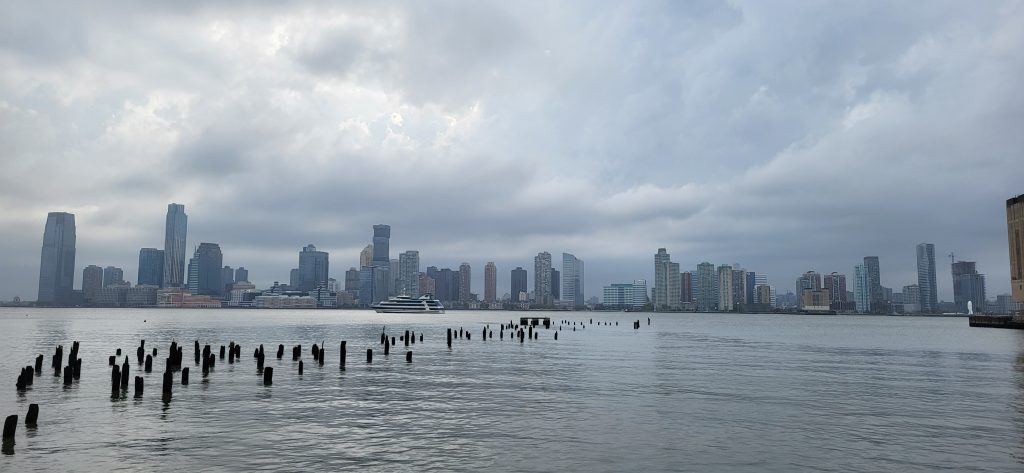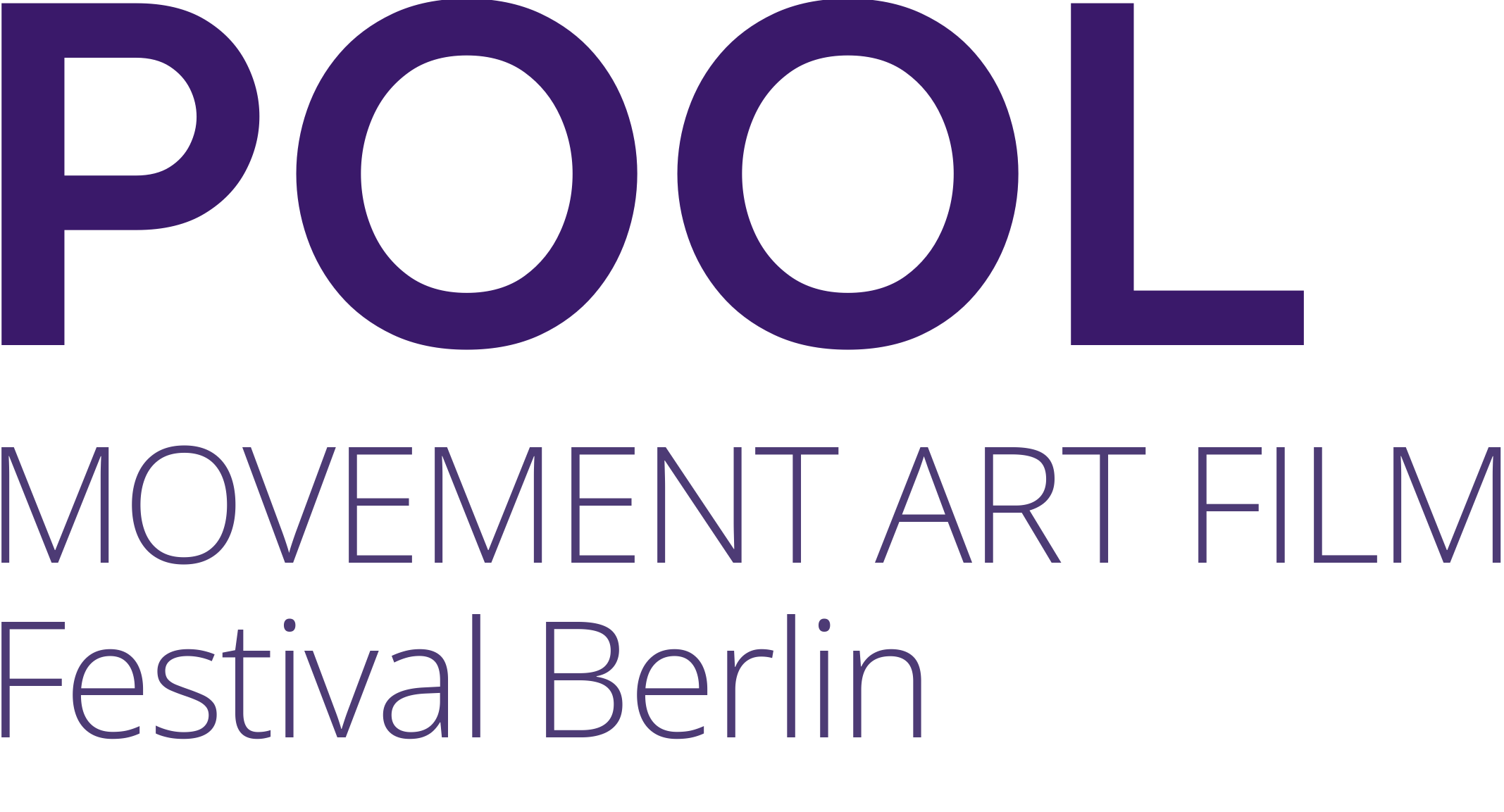NEW YORK TRACES —
Behind the facade, a garden awaits
A journey from New York’s East Village to SoHo, following the path of research and the origins of the films of the format POOL Shine – New York Traces.
15.9.2023
Article and images by Sarah Möller
***
1
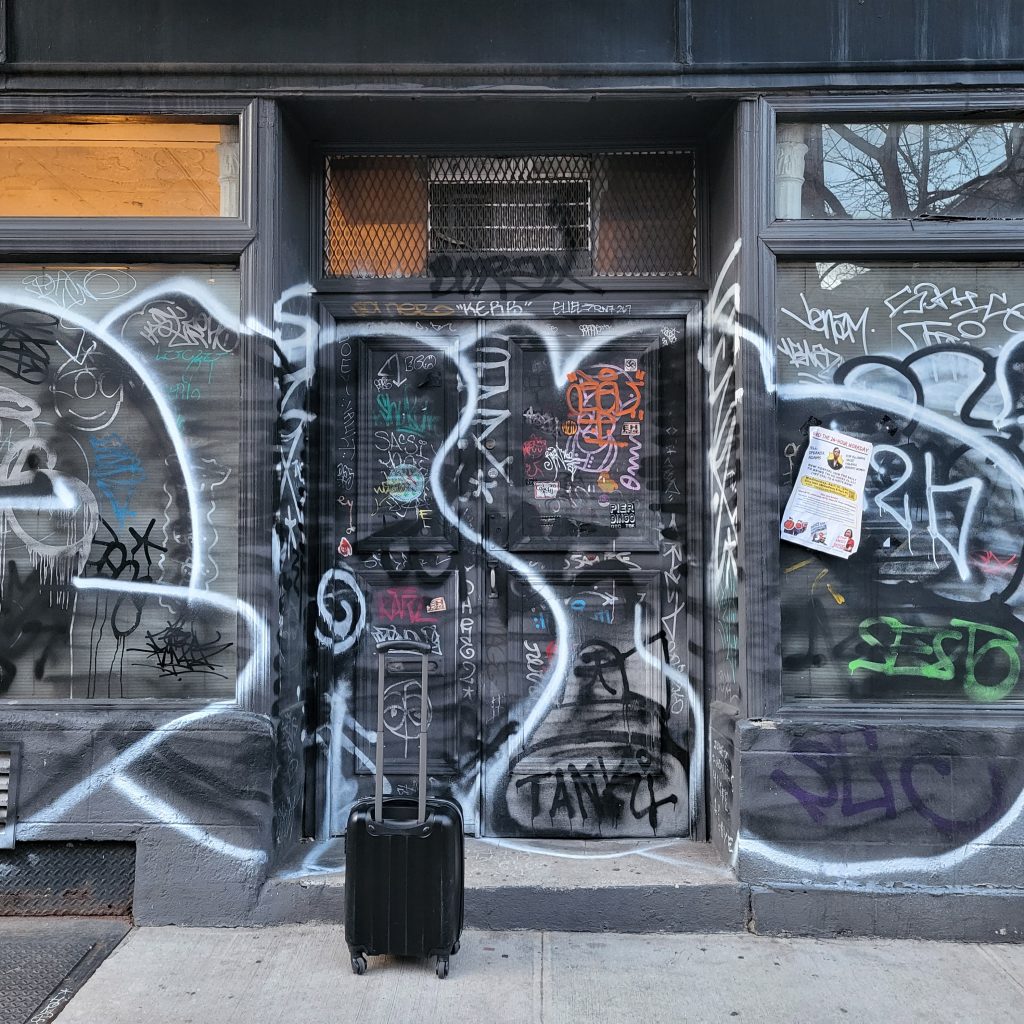
April 4, 2023. Berlin – New York. Arrival in front of a door full of graffiti, an apparently abandoned shop in the middle of East Village at 4th street – nowadays a trendy, upscale neighborhood. The door: a reminiscence of a mythical past, of a city in crisis that gave birth to a radical, wild, and visionary art scene that still shapes the present. The door is present, the key in my hands. I enter the home of THE SCHOOL OF HARD KNOCKS and its director, the choreographer and conceptual artist Yoshiko Chuma. In the following days members of the School are stopping by – talking, listening, observing, learning, eating! – at the University of Life, preparing for the final graduation, a celebration of 40 years of existence of Chuma’s company. Under the title SHOCKWAVE DELAY – a series of performances will happen later in June 2023 at La MaMa Theater (we will pass by).
As I enter through the door, my gaze falls to the floor. On the ground, film cans are piled up below a shelve – I recognize some of the titles, including August 27, 1979 – The Girl Can’t Help It (1979) – one of my favorite films by Chuma that we digitized in 2016 when the format POOL SHINE – New York Traces was just starting out. At the very bottom of the small film can tower, I discover a reel that literally serves as the foundation of Chuma’s 40-year journey with her company, or at least, as namesake: the film ‘THE SCHOOL OF HARD KNOCKS’.
The film was originally part of a sound-dance-image performance by Chuma, the filmmaker Jacob Burckhardt and the composer Alvin Curran, commissioned by the Venice film festival in 1980. (Read Jacob Burckhardt’s text on the creation process).
At the very beginning of the film, the door that I have just entered through appears, despite a first burst of color, all in white: carte blanche. Chuma and the actor John Nesci are coming out, carrying white squared tables with uneven legs.
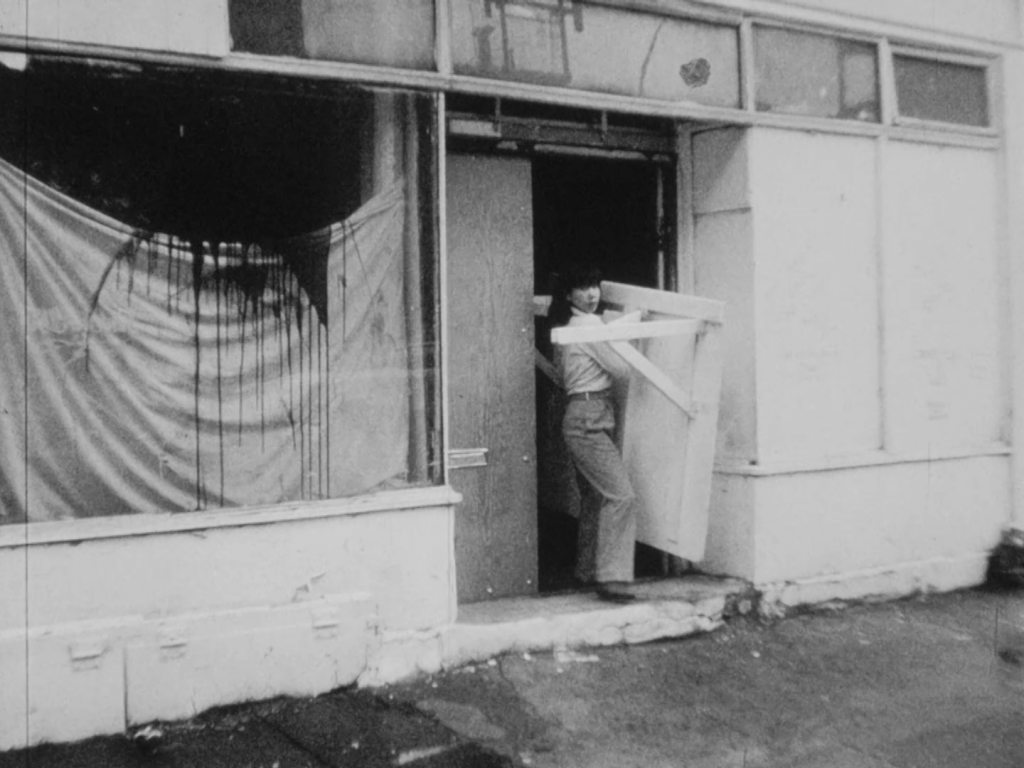
2
I follow the two of them, more than 40 years later, stepping out again on 4th street, and walking further west. After a while the brick buildings of La MaMa Experimental Theatre Club appear on my left. A dance festival is happening there these days, La MaMa Moves!, curated by Nicky Paraiso, who is standing on the sidewalk when I arrive, and warmly welcomes me. Paraiso is not only the curator of the fesitval, but active as actor, musician, writer, and performance artist. He appears in the film Book of Days by Meredith Monk that was presented at POOL SHINE in 2019. We were more than happy that Nicky could join us at that time in person.
The following days I have the chance to attend a series of performances of the festival, including the premier of Broken Theater by dancer and choreographer Bobbi Jene Smith. Though we have never met before Smith feels familiar to me, as she is performing in the films Lost Horse, True Love Waits and Home Alone by filmmaker and POOL artist prize winner Adi Halfin.
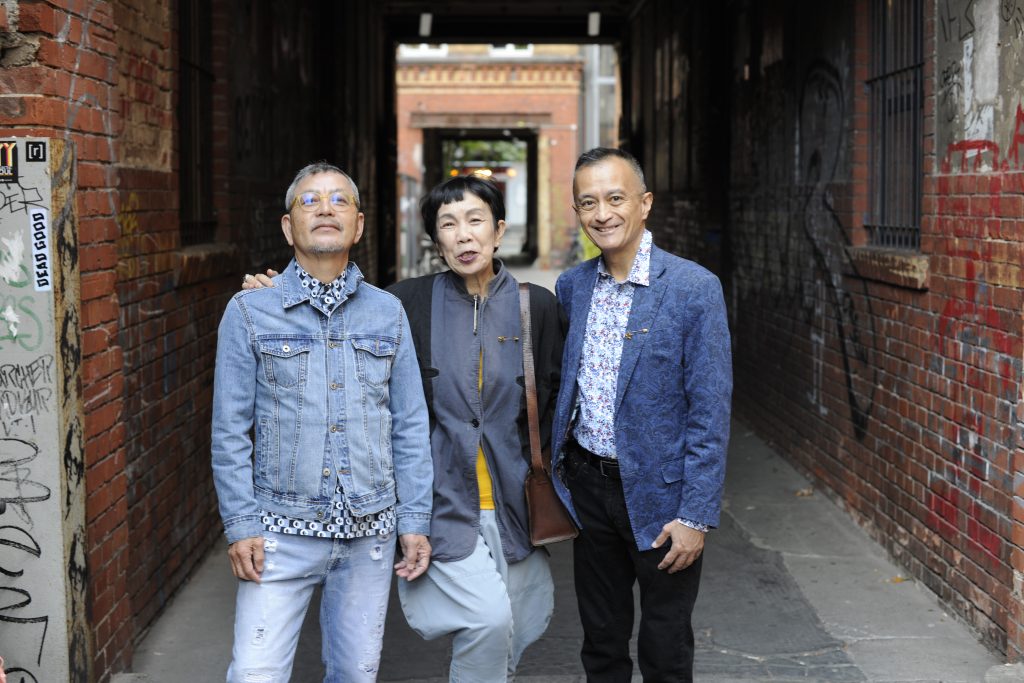
Photo: Barbara Dietl
April 8, 2023. For the second time, also our POOL SHINE format is part of La MaMa Moves!. To get to the venue of the screening, we need to make a small excursion on the map, moving further north. At 4th Avenue close to Union Square, I enter the studio of the Center for Remembering and Sharing, where our screening will take place. The architecture is captivating: smooth, curved white walls, a wide window showing the horizon of the city, functioning as an almost metaphorical interface between inner and outer world. It’s no surprise that the architects of the office CLOUDS won a 2016 AIANY Interiors Design Award for their intriguing work. The space itself is not of huge size, the screening is intimate.
We present four films, starting with the iconic Hand Movie by Yvonne Rainer, followed by her work Trio Film featuring dancers Becky Arnold and Steve Paxton, and filmed by Phill Niblock, at whose loft we will make a stop later. In the film Rainer Variations, that follows next in the program, the video artist Charles Atlas modifies and samples an interview with Yvonne Rainer, putting her words into the mouth of three other performers, and pairing political and aesthetical sharpness with a unique sense of humor. I was very pleased that Atlas, who is an influential artist in the field of dance film, joined the screening in person.
Last but not least, we presented the film THE SCHOOL OF HARD KNOCKS. After a long Sleeping Beauty slumber in its metal can, a digitized version of the 16mm -film was shared with an audience on that day. The film is also presented at Zionskirche in Berlin as part of POOL 23. A poetic journey from New York’s urban landscape of the 80s to the natural environment of Maine. Chuma and Burckhardt describe that they could barely remember the content of the film, or the performance in Venice of which the film was part of. It reminds me that a film is always also a document, a photographic imprint of a past, that shapes our memories, brings forgotten moments back, and transforms them at the same time into something else, something for its own.
3
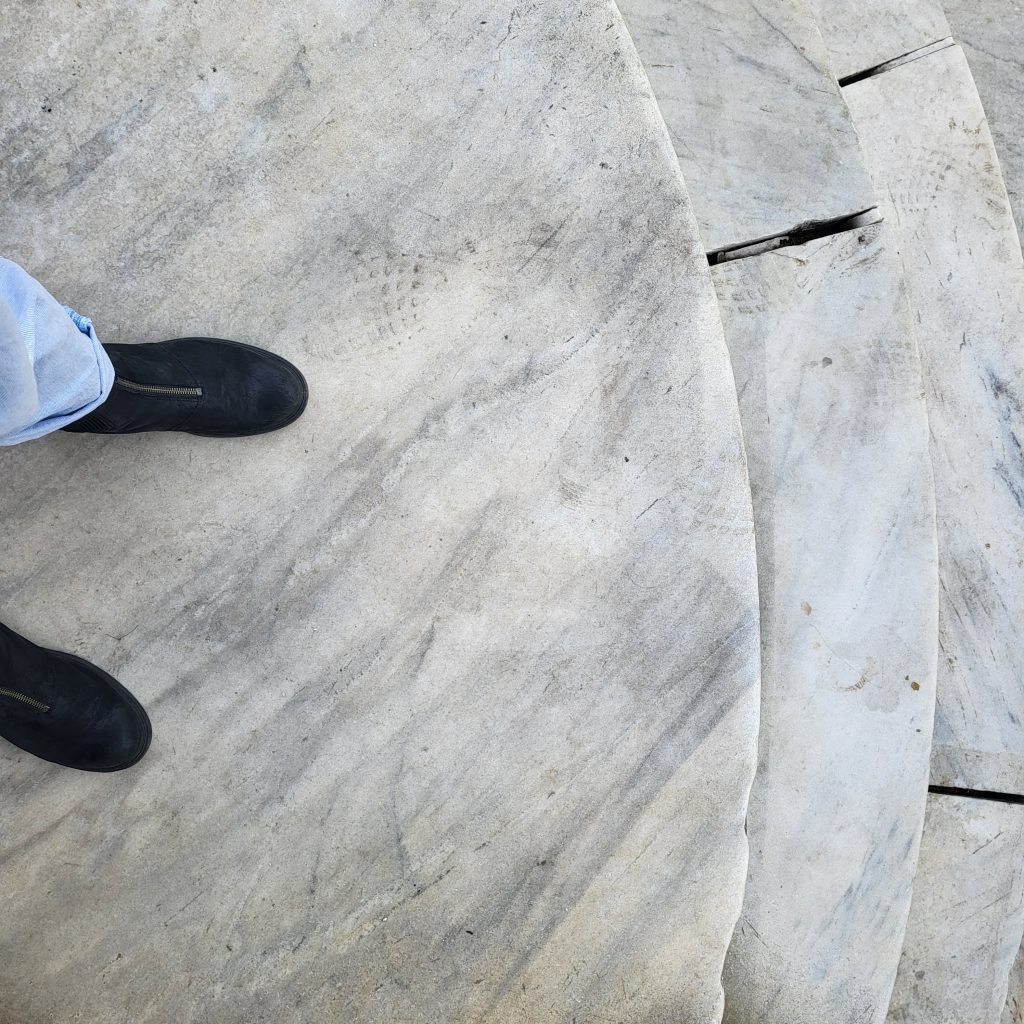
We jump back on 4th street. I’m moving further west, crossing Lafayette Street and the Broadway, passing the campus of the New York University until I finally reach Washington Square. Here, I’m standing at the entrance of the Judson Memorial Church. In the early 1960’s, a group of interdisciplinary artists showcased a series of “concerts” at the church’s interior with its blue-yellow painted, reduced arch. Breaking with the rules of Ballet and Modern Dance, they brought about a remarkable, dance historical change. The Judson Dance Theater, how it was later referred to, diverged from theatrical dance and its establishments, and searched both aesthetically and organisationally, for new structures and formats within the artform and the field. The aesthetic material, as movement, sound, film, text, or objects, was concerned with the everyday, and composed in a fragmentary and collage-like manner. Classical narrative structures were overruled by composition techniques that obey new systems of rule and incorporate playfulness and chance in the mix. The different artforms influenced each other: from music to dance to film to poetry.
The research for POOL SHINE – NEW YORK TRACES format began with the Judson Dance Theater as its focal point. The work of several members of the group was presented as part of POOL SHINE’s program over the past years. Not only Yvonne Rainer’s films, but also works by Elaine Summers, Meredith Monk and Douglas Dunn, who we will visit next, were included into the screening evenings.
Today, I’m joining a contemporary performance at the church, curated by The Queer Collective Pioneers Go East. It feels good to experience the space as a vivid venue for the arts, after digging deeply into its history far away in Berlin and entering the hall with many black and white photographs of the performances of the Judson Dance Theater in my memory. However, these images blend in with what I’m seeing now, and I wonder whether it might be difficult for young artists in New York to break through the dust of the famous artistic past. But this might be only a subjective impression.
Once again, outside the church, I try to capture the building with my camera. However, a continuous stream of passing and parked cars obstructs the view. So, I decide to collect some details of the church’s facade, which was built in the late 19th century in the style of the Italian Renaissance, and is adorned with ornaments.
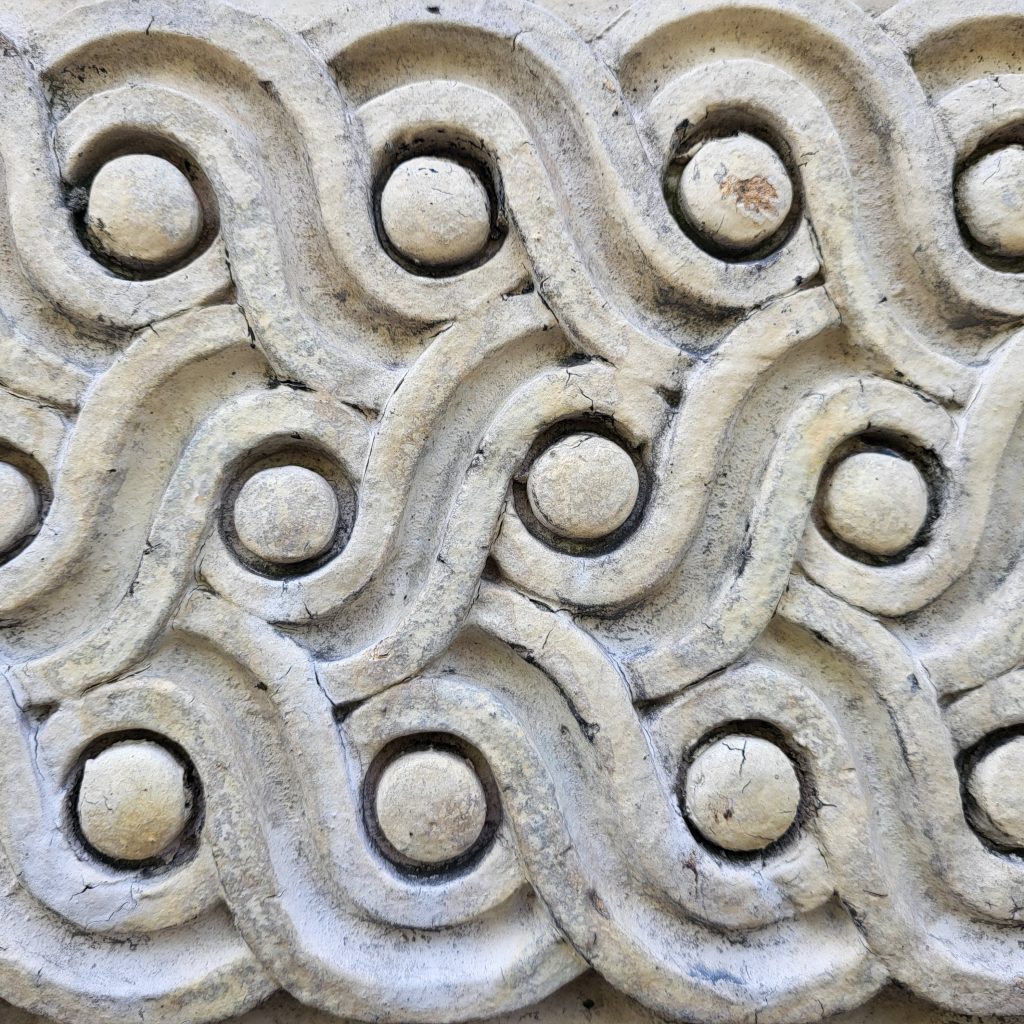
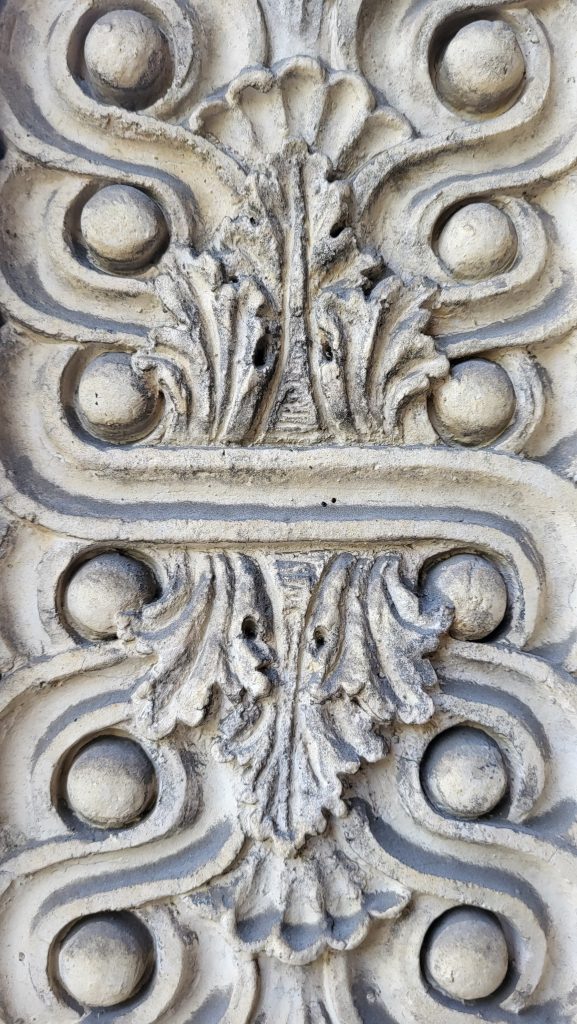
4
April 21, 2023. I stroll southward towards SoHo, heading back to Broadway. In front of Number 541, I stop. The building complex (537-541) was acquired in 1974 by Fluxus artist George Maciunas who transformed it alongside several other buildings in SoHo to an artist house. The lofts became a working space and home for many artists in the following decades, among them Trisha Brown, Lucinda Childs, Joan Jonas, Nam June Paik, David Gordon, Elaine Summers, Simone Forti, and Douglas Dunn – at whose studio I’m ringing right now. Stepping out of the elevator on the 3rd floor, I enter a space full of colors. I’m invited to join a GARDEN PARTY – the new piece of Douglas Dunn + Dancers. The mirrors in the studio are painted in vibrant tones, surrounded by paper plant ornaments and borders that blend into a sea of flowers, designed by visual artist Mimi Gross. Within an hour, a magical journey unfolds where individual episodes melt into one another. A true GARDEN PARTY – filled with romance, secrets, depth, dance, and joy. I’m incredibly thankful that I could join the performance. We are a small audience that night, as it is the dress rehearsal. On the day of the premiere, I should already be on my way back to Berlin.
In May 2018 I visited Dunn’s studio for the first time when we presented POOL SHINE format “back” in New York. Dunn contributed with two films RUBBLE DANCE, LONG ISLAND CITY (1991) and DANCERS, BUILDINGS and PEOPLE in the STREET (1986) that he created together with the photographer and filmmaker Rudy Burckhardt. It was a huge pleasure when Douglas Dunn joined us later in September 2018 for the screening of these films in Berlin.
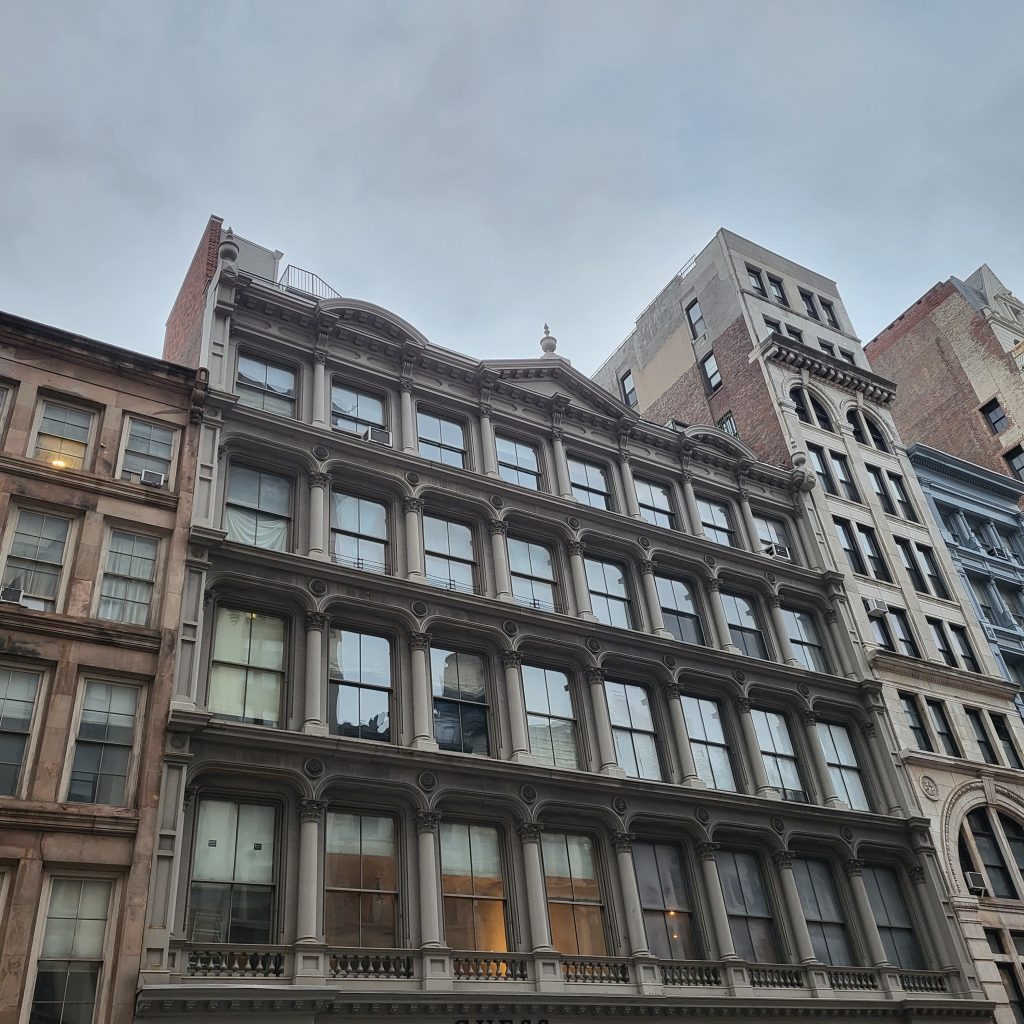

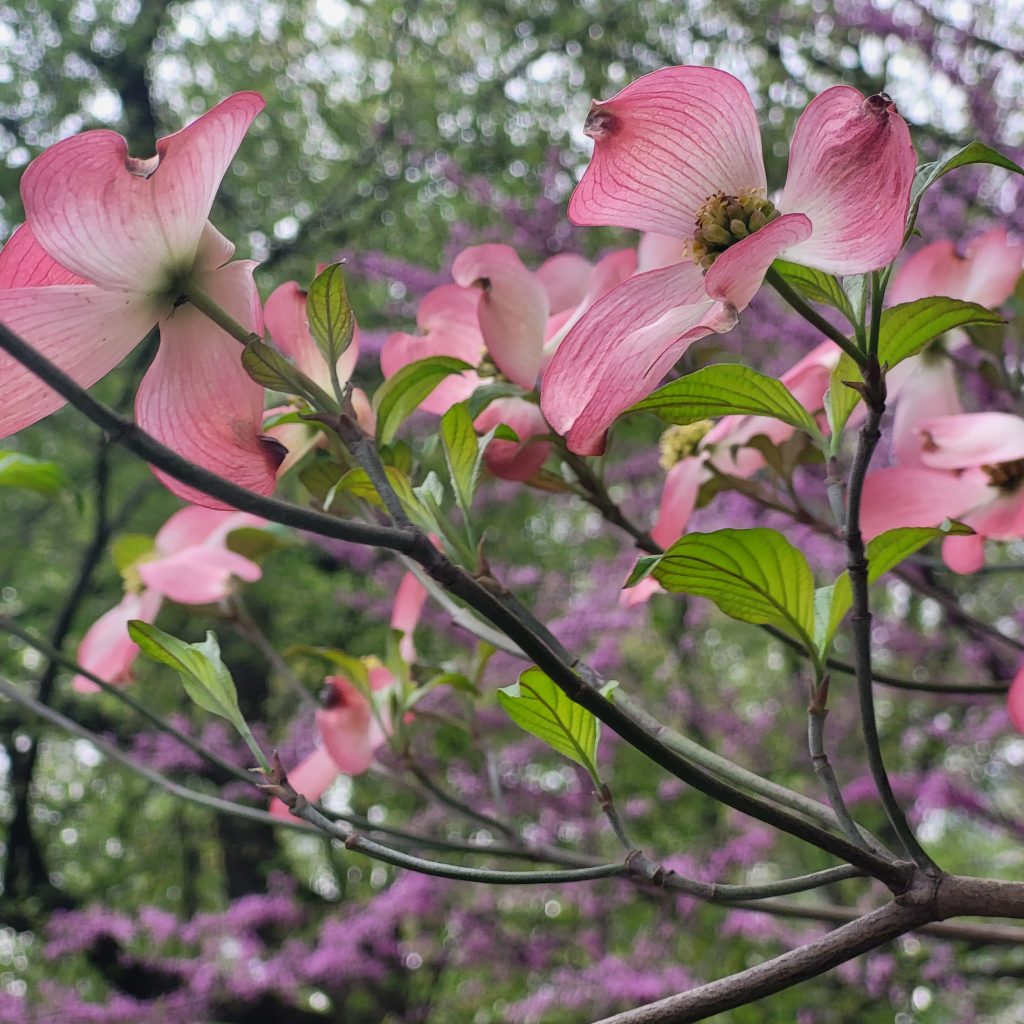
5
I walk further southwards to Centre Street, arriving at a building with a scaffolded facade. This time, the door remains locked to me as the resident of one of the lofts, the composer and filmmaker Phill Niblock, has travelled for a concert to Berlin – what a coincident. Almost one year prior to this moment I was lucky, and Niblock, who is frequently touring, was at home and welcomed me at his place.
I first saw a work of him at the age of 20 when I was studying in Lyon, France. On the river of Saône, in an anchored boat that was transformed into an underground cultural venue, Niblock’s film The Movement of People Working was shown, accompanied by his characteristic minimalist drone sound composition. Having observed the rhythms of manual labor for over three hours while surrounded by the mesmerizing tones, I began to experience a sense of trance. The artwork left me with a profound and lasting experience – never mind that I could not even remember Niblock’s name at that time. Fortunately, our paths crossed again some years later.
In 2016 Niblock attended POOL for the screening of Rainer’s Trio Film, for which he did the cinematography. I remember how he said that it was the first time that he saw the film after its creation in 1968. In the following years Niblock’s work is omnipresent in the program of POOL SHINE. In 2017 we’ve presented his film Annie, featuring the dancer, Ann Danoff. Later in 2019 he appeared once more as cinematographer, for the film Children by Meredith Monk.
In June 2022 we finally sit together in his kitchen in New York with a glass of wine. I’m telling him that I am interested in his close friend Dave Gearey’s films that he created together with choreographer Dana Reitz. Until then I’ve only read about the films in the catalogue of the 83’ filmdance festival in New York, organized by the Experimental Intermedia Foundation, that Niblock took over as director in 1985 and continues to lead to this day. By surprise, Niblock informs me that he also collaborated with Reitz on a film titled 3 Locations. It turns out that the film is a wonderful piece of work and fits perfectly into our program. We’ve showcased it in 2022 alongside the films by Gearey that we had finally digitized in collaboration with the Filmmaker’s Cooperative.
After a while, Niblock, his assistant and me decide to depart to a gallery opening. When leaving the kitchen, I take a look at his huge open loft space that over decades has been a venue for many performances, concerts and screenings. It was also here that the film Terrace of Unintelligibility with the cellist and singer Arthur Russel was recorded – another work of Niblock that is part of this year’s POOL SHINE edition.
6
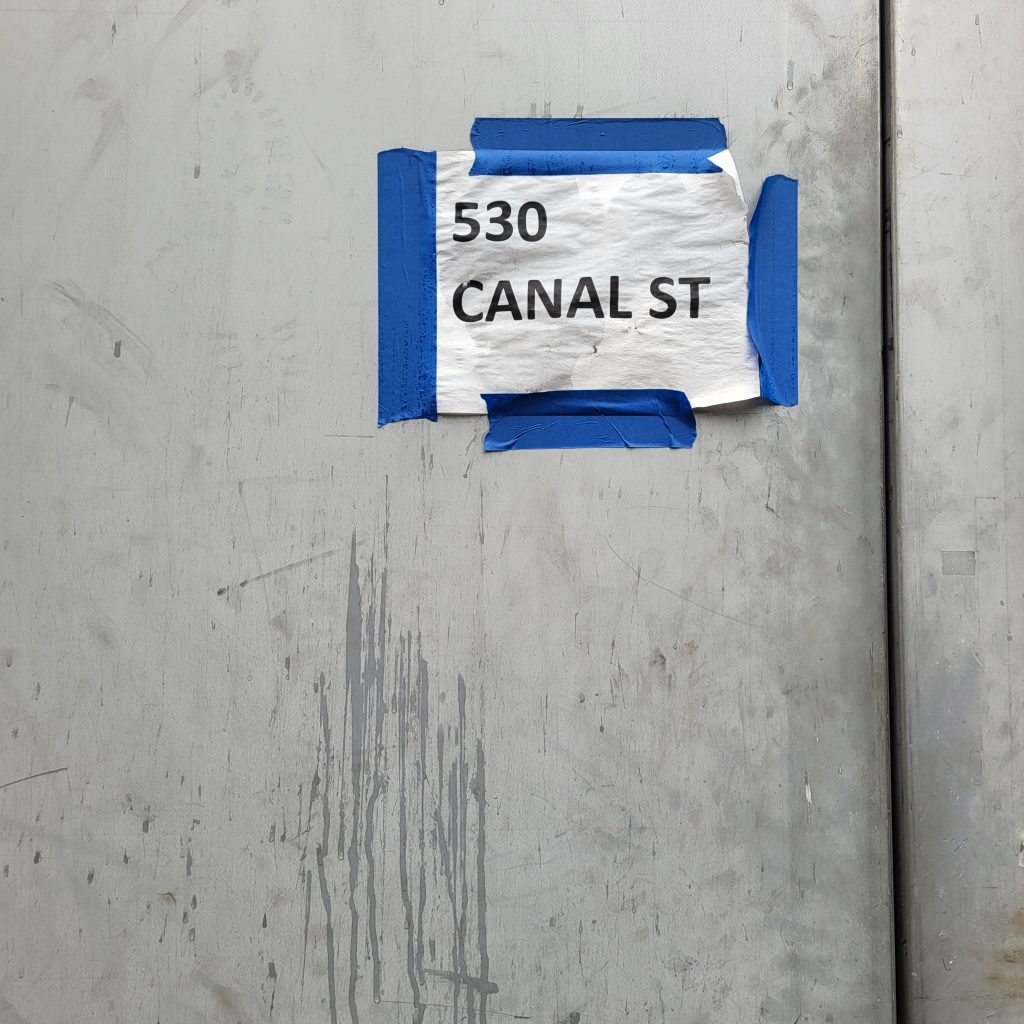
April 22, 2023. Slowly, we are reaching the end of our journey. I walk a little bit more south, and then turn onto Canal Street, heading west. At the very end of the Street, I reach the building No 530, encased by construction fences. Yoshiko tells me that she had a studio here at the end of the 70’s and that the building was especially designated for female artists.
Unfortunately, I can’t find out more about the building’s history and background. I do know that also the filmmaker Pooh Kaye, from whom we presented the film Inside the House of Floating Paper and Sticks on the Move, was living and working at one of the building’s lofts, next to Laurie Anderson who is still residing there with her studio. We wish so much to present her music clip of O Superman this year, but the huge licensing company behind it feels like a black box, in which every request disappears. So, until we manage, you can find the clip on Youtube.
In front of the building, a large traffic jam has developed, and it feels almost impossible to cross the street to reach the Hudson Riverside. But after a while I find my path amid the honking cars which allows me to finish the article with a panoramic view of New Jersey.
I would like to thank all those who supported and accompanied this journey and made POOL SHINE format possible through their films and presence so far. Thanks for all those inspiring and warm encounters, for welcoming me and for sharing your thoughts, ideas, memories, and work. A special thanks to Yoshiko Chuma, who tirelessly forged bridges for us and established connections to many of the artists mentioned above – and, last but not least, contributed a series of incredible art works by herself.
